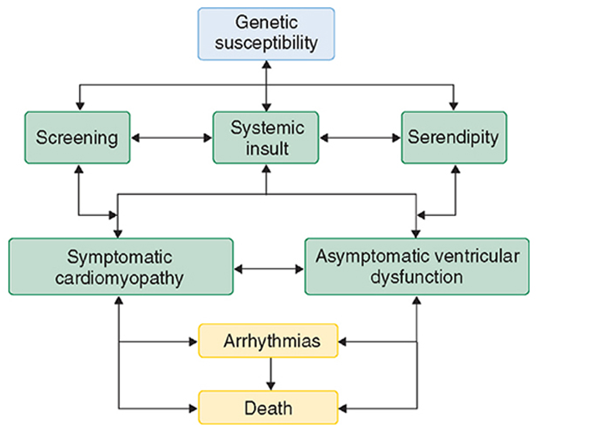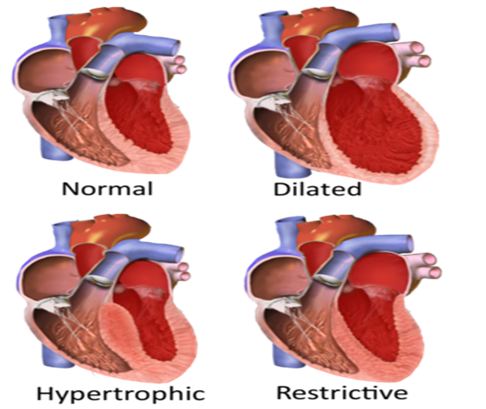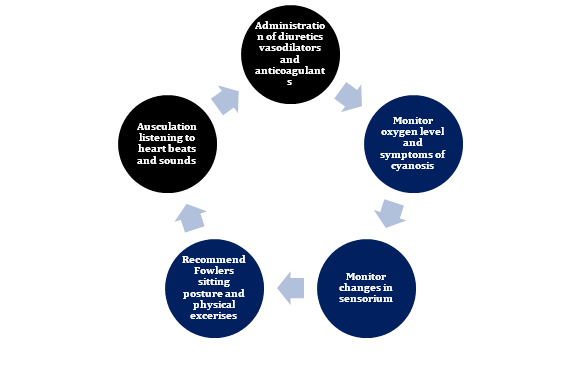patient management assignment on nursing care for Cardiomyopathy patients
Question
Task: What is Cardiomyopathy and how can nurses used patient management assignment strategies to handle patients after diagnosis
Answer
Introduction
This patient management assignmentfocuses on analysingCardiomyopathy. Cardiomyopathy is a serious condition in which the cardiac muscles cannot function properly which makes it very difficult for the heart to pump the blood. The diseased conditions are called so as the myocardium chamber of the heart is affected. This condition makes the heart stiffen, and causes scarring of the heart tissue, owing to which the heart fails to pump blood t the rest of the body parts. As a result of this inefficient blood pumping, the patient often experiences fatigue, shortness of breath, and palpitations. Cardiomyopathy if left untreated can worsen over time.
As per research done on this patient management assignment, patients eventually culminates in heart failure or cardiac arrest. Cardiomyopathy can be of several types e.g dilated, hypertrophic, restrictive, etc depending on the manifestations associated with the condition. Cardiomyopathy can also cause irregular heartbeats, cardiac failure, and heart valve disease. Treatment for cardiomyopathy involves ambulatory monitoring to track the rhythm of the heart. The purpose of this report is to provide helpful insight into cardiomyopathy, its pathophysiology, and the management plan and nursing interventions undertaken by nurses to deal with this diseased condition. The report would also conclude by providing some information on how the knowledge gained through writing this assignment is beneficial for nursing practice.
Pathophysiology of cardiomyopathy
Cardiomyopathy is a serious condition that can affect people irrespective of their age, gender, or race, and as per patient management assignment research, it is common in adults. Cardiomyopathy largely affects the myocardium cardiac muscles and can cause structural and functional abnormalities that tend to affect the pumping action of the heart. In most cardiomyopathies, blood outflow is obstructed in the cardiac cycle. Cardiomyopathies have been better understood using advanced clinical and genomic studies. Cardiomyopathy is highly prevalent among children and adults. Dilated cardiomyopathy can occur at any stage and is likely to occur more among males than in females. According to a study by (Kujath& Frei, J, 2022). cardiomyopathy occurs in children and accounts for around 60% of total cases. This condition is marked by ventricular dilation that involves thickening of the ventricular walls along with enlargement of the walls, as per patient management assignment findings this can eventually lead to decompensated cardiac failure. Such deadly conditions often necessitate heart transplantation.

Figure 1: Consequences of cardiomyopathy
(Source: Ren et al. 2021).
Dilated cardiomyopathy has been linked to genetic issues. Several gene defects occur in cardiac muscle cells known as cardiomyocytes wherein the structural elements are largely affected. Apart from this genetic defects in ion channels, cytoskeletal framework and mitochondria have also been documented (Schoene et al. 2021) Inflammation, malnutrition, and the presence of infectious, hormonal disorders have also been associated with cardiomyopathy.
There are some forms of cardiomyopathies that have been linked to genetic predisposition on this patient management assignment. For instance, dilated cardiomyopathy is particularly common among black people and males than females and whites. Cardiomyopathy is broadly classified into ischemic and nonischemic cardiopathy based on its link to coronary artery disease (Tschöpe et al., 2021). Likewise, alcohol overuse has also been responsible for around 40% of cases of cardiomyopathy (Tschöpe et al., 2021). The majority of the patients with cardiomyopathy exhibit symptoms such as dyspnea, fatigue, chest pain or angina, that eventually culminate in heart failure. But there are other several types of cardiomyopathies that exists. They are mentioned below:
Dilated cardiomyopathy: This is a condition in which there is dilation of the heart’s blood pumping chambers (Tschöpe et al., 2021).
Hypertrophic cardiomyopathy: This is characterised by the thickening of cardiac muscles.
Arrhythmogenic right ventricular dysplasia(ARVD): This causes arrhythmia or irregular heartbeats.
Restrictive cardiomyopathy: This causes stiffening and scarring of the cardiac muscle
Chemotherapy-induced cardiomyopathy: In this heart is damaged owing to cancer treatment.
Peripartum cardiomyopathy: This is congestive heart failure that proceeds from a complicated pregnancy (Ren et al., 2021).

Figure 2: Different forms of cardiomyopathy
Source: (Ren et al. 2021)
Below are certain risk factors of cardiomyopathy identified on this patient management assignment:
Autoimmune diseases like diseases of the connective tissue can cause cardiomyopathy or myocardial infarction.
High cholesterol levels in individuals, can lead to atherosclerosis and clogging of the arterial blood vessels of the heart which can, in turn, lead to cardiac diseased conditions like cardiomyopathy.
Persistence of thyroid or other hormone issues can also increase the chances of such cardiac diseased conditions (Ware et al., 2021). Familial history of cardiomyopathy can also increase the chances of subsequent heart failure or cardiac arrest. Patients having a history of previous heart attacks are more likely to have such cardiac complications. The symptoms of cardiomyopathy include feeling fatigued, undergoing heart palpitations, dyspnoea or shortness of breath, swelling or accumulation of fluid in the legs known as oedema as well as syncope (loss of consciousness or fainting) (Hollenberg& Singer, 2021).
Nursing interventions in cardiomyopathy
A nursing care plan or intervention for patients with cardiomyopathy and related heart failure involves supporting the patients to improve their heart pumping function for alleviating the complications. Nursing interventions aim to reduce fatigue in patients and relieve patients of the symptoms of fluid overload. The following nursing interventions are likely to improve the conditions of patients with cardiomyopathy.
a. Tachycardia is an increased heart rate which is very common in patients with cardiomyopathy, as persistent tachycardia is detrimental to the patient and is likely to cause heart failure, appropriate heart rate control is essential for better patient outcomes (Ordóñez Piedra et al., 2021). The nurse plays an imperative role in auscultating( listening to the heart sounds of the patient) apical pulses and assessing the heart rate.
b. Assessing the cardiac rhythm and documenting dysrhythmias are very important for the patient. As dysrhythmia or irregular heart rhythm is a common occurrence in patients with cardiomyopathy. Myocardial fibrosis and atrial fibrillation are other common dysrhythmia associated symptoms (Ordóñez Piedra et al. 2021). Hence periodic monitoring of cardiac rhythm is very crucial.
c. The nurse must also check for palpitations or irregular heartbeat in the patient and must monitor the blood pressure of the patient. An elevation of blood pressure is likely to increase in acute heart failure. Monitoring of B.P is also important for determining the adequate pharmacological sage and other use of useful interventions like vasodilators and vasopressors (Ordóñez Piedra et al. 2021).
d. As in the case of cardiomyopathy, the cardiac output is low, it may cause mottling of the skin resulting in clue or grey skin colouration, This can be attributed to deoxygenation of blood. Hence such conditions need to be carefully inspected. Cyanosis or skin pallor is also quite common in the patients and this also needs to be carefully inspected by the nurses.
e. The nurse also needs to monitor the urine output of the patient. Cardiomyopathy is fen found to be associated with a decrease in renal function and urine output. The patient often develops resistance to diuretics treatment which leads to decreased urine output. The urine output is significantly low during the daytime as the fluid balance shifts to tissue whereas as increases during the nighttime owing to increased renal perfusion.
f. A patient with cardiomyopathy also experiences psychological issues like anxiety, depression, confusion, irritability and suffers from disoriented speech (Li et al., 2021). Owing to low oxygen levels in the body or hypoxia in the brain, the patient often experiences restlessness and forgetfulness. Depression is particularly important in patients dwelling with cardiac failure. Such patients are at increased risk of mortality. Hence, the nurse should monitor changes in sensorium and should provide cognitive behavioural therapy and counselling to the patient for calming his symptoms of anxiety and depression (Jiang et al., 2021). The nurse must also ensure that the patient is provided with a restful environment that would encourage periods f resting and sleep. Any unnecessary disturbances must be controlled. If a patient has severe cardiomyopathy he might be advised to rest in bed, whereas if a patient is having moderate cardiomyopathy he might be ambulatory with very limited physical activity.
g. As per the nursing patient management assignment guidelines a nurse must monitor the oxygen saturation level in the patient, and this is an important parameter for the diagnosis of cardiac failure in acute settings. Supplemental oxygen saturation must be given to the patient to relieve him of the symptoms of cardiac ischemia, hypoxemia and pulmonary congestion emanating from hypoxia (Jiang et al., 2021). The pulse oximeter can be used to effectively monitor the effectiveness of the oxygen supplementation given to the patient.
h. The nurse must advise the patient to assume a high Fowler’s position. This position is also termed the sitting position. In such a position, the legs of the patient might be straight or slightly bent. This position is often used during chest surgeries. Putting the patient in such a position is likely to allow better chest expansion for improving the pulmonary lung capacity of the patient (Zhang & Chen, 2022). The pulomary congestion the patient suffers owing to cariomyopathy is reduced or alleviated in such a position. Pulmonary congestion often leads to the production of a productive cough which is likely to be alleviated owing to such sitting postures.
i. Reduced cardiac output also increases the risk of conditions like pulmonary thrombosis or thrombophlebitis. The nurse must look for thrombosis like symptoms that is likely to include swelling, redness and pallor in the legs. Likewise, the nurse must also check for calf tenderness.
j. The patient management assignment also required for the patient to be provided with a bedside commode and stool softeners. This is likely to decrease the need for the patient to frequently visit the bathrooms or relieve them of the issues of struggling to use bedpans. The nurse must encourage active and passive physical exercises for the patient. Nurses must be encouraged for at least 30 minutes of physical activity on daily basis.

Figure 3: Nursing interventions in cardiomyopathy
(Source: Created by author)
k. The patient must be administered diuretics which are the first line of drugs for patients having cardiomyopathy and related issues of pulmonary oedema and cardiac dilation. Diuretics are likely to relieve these symptoms and improve the heart health of the patient. Commonly used diuretics include micro sides, such as hydrochlorothiazide, furosemide, and Aldactone (Zhang & Chen, 2022). Vasodilators and arterial dilators such as isosorbide dinitrate, hydralazine and nitroglycerin, sodium nitroprusside and nesiritide must be administered where and when required (Zhang & Chen, 2022). Anticoagulants such as coumadin or warfarin and heparin need to give for preventing complications such as atrial fibrillation or other thromboembolic events. Anticoagulants are also likely to reduce incidences of dysrhythmia and the risk of previous thrombotic disorders.
Application of knowledge
The knowledge gained through this assignment on cardiomyopathy would better prepare me to educate my patients and help me carry out my role as a nurse effectively. This assignment would enable me to develop my self-knowledge and awareness of cardiomyopathy and to deal with such patients in the future. I believe self-reflection and a strong sense of inquiry are a must for nursing professionals. For this assignment, I have undertaken extensive research for understanding the pathophysiology of cardiomyopathy and myocardial infarction.
As per the research done for this patient management assignment, Cardiomyopathy is common in both adults and children and is a serious condition which needs to be dealt with effectively by health care professionals and nurses. I believe understanding the aetiology of this condition, the different types of cardiomyopathy, and its associated signs and symptoms have helped me to develop and expand on the clinical knowledge gained so far and to link to previous ideas and knowledge gained in the lectures of my graduate nursing school. I have also taken the help of search engines to understand and reflect upon my ideas on the appropriate nursing interventions such as monitoring associated complications of cardiomyopathy and drug therapy for alleviating patients of the various symptoms. This would help me to engage with my work as a nurse in the future and at the same time increase my interest and motivation to provide the best quality care to the patients.
Conclusion
Cardiomyopathy is a serious condition of the cardiac system that can be fatal if left untreated or ignored. Cardiomyopathy is prevalent among both men and women and children as well as adults. There are several environmental as well as genetic factors contributing to the condition. Understanding the pathophysiology, and aetiology of the diseased condition is an absolute prerequisite in the order to appropriately diagnose the patient and effectively monitor their cardiac health, signs and symptoms.
Nurses have a very imperative role in the management of patients with cardiomyopathy. The different nursing interventions that can alleviate the symptoms of cardiomyopathy have been well articulated in this report. This involves the administration of anticoagulants and vasodilators as well as diuretics to the patient. Besides this, the patient must also be provided appropriate psychological counselling to calm symptoms of anxiety and depression associated with cardiomyopathy. Appropriate sitting postures along with bed rest and medications and physical exercises or ambulatory movement would be essential for the treatment of such cardiac conditions. This patient management assignment concludes by emphasizing on the knowledge gained through the assignment can be useful for future professional nursing practice.
References
Hollenberg, S. M., & Singer, M. (2021). Pathophysiology of sepsis-induced cardiomyopathy. Nature Reviews Cardiology, patient management assignment18(6), 424-434. [Available from: https://www.nature.com/articles/s41569-020-00492-2]
Jiang, Y., Koh, K. W. L., Ramachandran, H. J., Tay, Y. K., Wu, V. X., Shorey, S., & Wang, W. (2021). Patients’ Experiences of a Nurse-Led, Home-Based Heart Failure Self-management Program: Findings From a Qualitative Process Evaluation. Journal of medical Internet research, 23(4), e28216. [Available from: https://www.jmir.org/2021/4/e28216/]
Kujath, A. S., & Frei, J. (2022). Orthopaedic Nursing and Heart Failure: A Review of Pathophysiology and Management. Orthopaedic Nursing, 41(1), 25-34. [Available from: https://www.ingentaconnect.com/content/wk/nor/2022/00000041/00000001/art00007]
Li, M., Li, Y., Meng, Q., Li, Y., Tian, X., Liu, R., & Fang, J. (2021). Effects of nurse-led transitional care interventions for patients with heart failure on healthcare utilization: A meta-analysis of randomized controlled trials. PloS one,patient management assignment16(12), e0261300. [Available from: https://journals.plos.org/plosone/articleid=10.1371/journal.pone.0261300]
OrdóñezPiedra, J., PonceBlandón, J. A., RoblesRomero, J. M., GómezSalgado, J., JiménezPicón, N., & RomeroMartín, M. (2021). Effectiveness of the Advanced Practice Nursing interventions in the patient with heart failure: A systematic review. Nursing Open, 8(4), 1879-1891. [Available from: https://onlinelibrary.wiley.com/doi/abs/10.1002/nop2.847] Ren, J., Wu, N. N., Wang, S., Sowers, J. R., & Zhang, Y. (2021). Obesity cardiomyopathy: evidence, mechanisms, and therapeutic implications. Physiological Reviews, 101(4), 1745-1807. [Available from: https://journals.physiology.org/doi/abs/10.1152/physrev.00030.2020]
Schoene, D., Schnekenberg, L. G., Pallesen, L. P., Barlinn, J., Puetz, V., Barlinn, K., &Siepmann, T. (2022). Pathophysiology of Cardiac Injury in COVID-19 Patients with Acute Ischaemic Stroke: What Do We Know So Far—A Review of the Current Literature. Life, patient management assignment12(1), 75. [Available from: https://www.mdpi.com/1437962] Tschöpe, C., Ammirati, E., Bozkurt, B., Caforio, A. L., Cooper, L. T., Felix, S. B., ... & Van Linthout, S. (2021). Myocarditis and inflammatory cardiomyopathy: current evidence and future directions. Nature Reviews Cardiology, 18(3), 169-193. [Available from: https://www.nature.com/articles/s41569-020-00435-x]
Ware, S. M., Wilkinson, J. D., Tariq, M., Schubert, J. A., Sridhar, A., Colan, S. D., ... &Pediatric Cardiomyopathy Registry Study Group. (2021). Genetic causes of cardiomyopathy in children: first results from the pediatric cardiomyopathy genes study. Journal of the American Heart Association, 10(9), e017731. [Available from: https://www.ahajournals.org/doi/abs/10.1161/JAHA.120.017731]
Zhang, A., & Chen, Q. (2022). Segmentation Algorithm-Based Safety Analysis of Cardiac Computed Tomography Angiography to Evaluate Doctor-Nurse-Patient Integrated Nursing Management for Cardiac Interventional Surgery. Computational and Mathematical Methods in Medicine, 2022. patient management assignment[Available from: https://www.hindawi.com/journals/cmmm/2022/2148566/]












